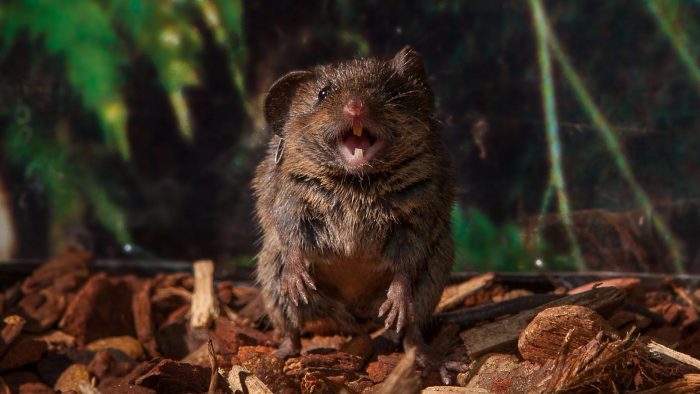CSHL’s Arkarup Banerjee shows that a mouse adjusts the timing of its song

By Daniel Dunaief
Animals don’t have clocks, telling them when and for how long to run on a treadmill, to eat whatever they catch or to call to each other from the tops of trees or the bottom of a forest.

The Alston’s singing mouse, which lives in Costa Rica, has a distinctive call that people can hear and that, more importantly, conveys meaning to other members of the species.
Using equipment to monitor neurons when a mouse offers songs of different length, Cold Spring Harbor Assistant Professor Arkarup Banerjee showed that these unusual rodents exhibit a form a temporal scaling that is akin to stretching or relaxing a rubber band. This scaling suggests that their brains are bending their processing of time to produce songs of different lengths.
“People have shown this kind of time stretching phenomenon in monkeys,” said Banerjee. It was unexpected and surprising that the same algorithm was used in the rodent motor cortex to control the flexibility of a motor pattern and action during vocalization.
Using recordings of neuronal activity over many weeks, Banerjee focused on a part of the mouse brain called the orofacial motor cortex (or OMC). He searched for differences in songs with particular durations and tempo.
Banerjee had set up a system in which he played back the recordings of Alston’s singing mice to his test subjects, who then responded to those songs. Mice generally respond with songs that are variable durations compared to when they sing alone.
These mice can adjust duration and tempo of these 10-second long songs while engaged in social communication.
People “do that all the time,” said Banerjee. “We change the volume of how loud we are speaking and we can change the tempo.”
The mice showed some vocal flexibility similar to other animals, including people.
These mice are singing the same song, with varying rhythms over shorter or longer periods of time. It is as if the same person were to sing “Happy Birthday” in 10 seconds or in 15 seconds.
Banerjee would like to know what is it in the mouse’s brain that allows for such flexibility. He had previously shown that the motor cortex is involved in vocal behavior, which meant he knew of at least one region where he could look for clues about how these rodents were controlling the flexibility of their songs.
By tracking the firing pattern of neurons in the OMC, he was able to relate neural activity to what the mice were doing in real time.
Neural activity expands or contracts in time, almost as if time is running faster or slower. These animals are experiencing relative time when it comes to producing their songs as they change their songs through a wide range of durations.
Pre-song activity
Even before an animal sings, Banerjee speculates its brain could be preparing for the sounds it’s going to make, much as we think of the words we want to say in a conversation or our response to a question before we move our mouths to reply or type on a keyboard to respond.
Songs also track with intruder status. An animal in a home cage sings a shorter song than an animal brought into a new cage.
Vocalizations may scale with social rank, which might help attract mates or serve other social purposes.
Females in the lab, which presumably reflect similar trends in the wild, tend to prefer the male that produces a longer song with a higher tempo, which could reflect their physical fitness and their position in the social hierarchy, according to research from Steve Phelps, Professor at the University of Texas at Austin in the Department of Integrative Biology.
Applications
While it’s a long way from the research he’s conducting to any potential human application, Banerjee could envision ways for these studies to shed light on communication processes and disorders.
The motor cortex in humans and primate is a larger region. Problems in these areas, from strokes or injuries, can result in aphasia, or the inability to articulate words properly. Banerjee plans to look at stroke models to see if the Alston’s singing mouse might provide clues about potential diagnostic or therapeutic clues.
“There are ways we can use this particular system to study cognitive deficits that show up” during articulation deficits such as those caused by strokes, said Banerjee. While he said scientists know the parts list of the brain regions involved in speaking, they don’t yet know how they all interact.
“If we did, we’d have a much better chance of knowing where it fails,” Banerjee explained. A challenge along this long process is learning how to generalize any finding in mice to humans. While difficult, this is not an impossible extrapolation, he suggested.
An effective model
Banerjee built a model prior to these experiments to connect neural activity with behavior.
“We had an extremely clear hypothesis about what should happen in the neural domain,” he said. “It was pretty gratifying to see that neurons change the way we predicted given the modeling.”
When the paper first came out about eight months ago in the scientific preprint bioRxiv, it received considerable attention from Banerjee’s colleagues working in similar fields. He went to India to give three talks and gave a recent talk at Emory University.
Outside of the lab, Banerjee and his wife Sanchari Ghosh, who live in Mineola, are enjoying watching the growth and development of their son Ahir, who was born a year and a half ago.
“It’s fascinating as a neuroscientist to watch his development and to see how a tiny human being learns about the world,” Banerjee said.
As for his work with this compelling mouse, Banerjee credited Phelps and his post doctoral advisor at New York University, Michael Long for doing important work on this mouse and for encouraging him to pursue research with this species. Long is a co-corresponding author on the paper. “It’s very gratifying to see that the expectation of what we can do with this species is starting to get fulfilled,” said Banerjee. “We can do these interesting and complex experiments and learn something about vocal interactions. I’m excited about the future.”
——————————————————-
SCIENCE ON SCREEN
The Cinema Arts Centre, 423 Park Ave., Huntington continues its Science on Screen series with a mind-expanding exploration of the mysteries of language and communication, featuring a lecture and Q&A with neuroscientist Arkarup Banerjee, of Cold Spring Harbor Laboratory, and a rare big-screen showing of Denis Villeneuve’s profound 2016 drama ARRIVAL on Tuesday, March 26 at 7 p.m..
Dr. Banerjee’s work explores the theme of decoding messages and touches on the fundamental assumptions of reality which are unpacked in the film. Discover how every species and culture’s unique symbols and codes shape our understanding of the world around us, and uncover the intriguing ways in which our brains navigate the limits and possibilities of language.
Tickets are $16, $10 members. To purchase in advance, visit www.cinemaartscentre.org.






